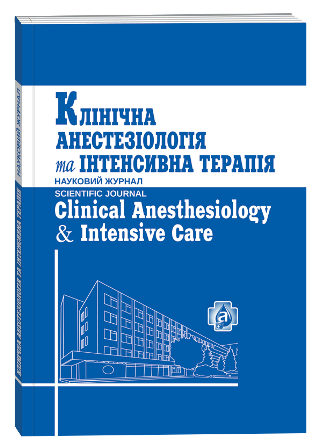THE CORRECTION OF GLUTAMATE EXITOTOXICITY IN PATIENTS WITH SEVERE HEAD INJURY
Keywords:
traumatic disease of the brain, quantitative EEG, heart rate variability, glutamate exitotoxicity, amantadine (PK-Merz)Abstract
Goal of study. The article presents the results of a study whose objective was to study the effectiveness of amantadine sulfate (PK-Merz) in patients with severe head injury for early neuroprotection due to a correction glutamate exitotoxicity. Study design: open prospective study. The study included 60 patients with a diagnosis of severe traumatic brain injury: the level of impaired consciousness at admission to the hospital from 4 to 8 points on the Glasgow coma scale, age from 20 to 50 years. Group 1 consisted of 30 patients who received therapy according to standard Protocol. 2nd group — 30 patients who additionally received amantadine (PK-Merz), which was used in a form of an infusion solution at a dose of 500 ml (200 mg) 2 times per day by slow intravenously for 7 days. There studied the cerebro- cardiac relationship in patients with severe head injury methods of quantitative electroencephalography and cross-correlation analysis of heart rate variability. Results and discussion. High and direct correlation between the increase in the level of consciousness on a scale of Glasgow-Pittsburgh and decreasing absolute spectral power in the Delta range in response to the introduction of amantadine (PK-Merz) were investigated. This indicated that after inclusion in the therapy amantadine (PK-Merz) there is a decrease in the glutamatergic activity (δ dicrease, the growth of α- and β1- and β2-rhythms) in patients with severe head injury resulted in higher levels of consciousness. This was combined with an increase in power of low-frequency (LF — low frequency) spectrum of HRV, reflecting a significant activation of stress mechanisms implementing adaptation. The decrease of glutamatergic activity by using amantadine (PK-Merz) was accompanied by activation of the cholinergic activity, and moderate activation of dopaminergic activity, primarily in the projection stem structures that helped to restore the level of consciousness. Patients found a sharp weakening of hemispheric interaction most coherent link in the main frequency bands of the EEG, reflecting the degree of inhibition of the cerebral cortex. In the dynamics of therapy with amantadine is a strengthening hemispheric relations coherent EEG, the output of the inhibitory state of the cortex. Conclusions. Already on the 3rd day of therapy, the chance of recovery of consciousness for 5 or more points on the GCS was higher in the group, which used in addition to standard treatment Protocol amantadine (PK-Merz) (ОR±95% CI= =6.5 (1.8–23.2), S=0.649). The use of amantadine (PK-Merz) in acute severe head injury caused a statistically significant reduction of the death and mortality risk (p=0,050). The risk of death on the 7th day was higher in the group which used only the standard complex treatment protocol (RR±95 % CI=0.273 (0.084–0.881).
References
Возможности количественной ЭЭГ в исследовании нейромедиаторных систем ЦНС при острой и хронической церебральной недостаточности / И. А. Андронова, Т. В. Черний, К. В. Назаренко [и др.] // Нейрохимические механизмы формирования адаптивных и патологических состояний мозга : материалы Всерос. конф. с междунар. участием, Санкт-Петербург ; Колтуши, 24–26 июня 2014 г. – СПб., 2014. – 2014. – С. 17.
Нейропротекция и нейропластичность : монография / И. Ф. Беленичев, В. И. Черний, Е. А. Нагорная [и др.]. – К. : Логос, 2015. – 512 с.
Кропотов Ю. Д. Количественная ЭЭГ, когнитивные вызванные потенциалы мозга человека и нейротерапия / Ю. Д. Кропотов. – Донецк : Изд. «Заславский А. Ю.», 2010. – 512 с.
Межцентральные отношения ЭЭГ как отражение системной организации мозга человека в норме и патологии / Г. Н. Болдырева, Л. А. Жаворонкова, Е. В. Шарова [и др.] //Журнал высшей нервной деятельности. – 2003. – Т. 53, № 6. – С. 1093–1099.
Никонов В. В. Роль антагонистов глутаматных рецепторов (ПК-мерц) в лечении повреждений мозга (обзор литературы) / В. В. Никонов, И. Б. Савицкая // Медицина неотложных состояний. – 2012. – № 5 (44). – С. 44–48.
Острова Т. В. Алгоритм діагностики реактивності ЦНС методами штучного інтелекту / Т. В. Острова, В. І. Черній, А. І. Шевченко. – Донецьк : ІПШІ МОНУ і НАНУ «Наука і освіта», 2004. – 180 с.
Шарова Е. В. Современные возможности ЭЭГ в анализе функциональных нарушений при тяжелых повреждениях головного мозга / Е. В. Шарова // Нейронауки: теоретичні та клінічні аспекти. – 2009. – Т. 5, № 1/2. – С. 49–58.
Ахметова Е. Р. Электроэнцефалографический анализ взаимодействия глутамат- и холинергической систем мозга : дис. ... канд. біол. наук / Е. Р. Ахметов. – Пущино, 2000. – 99 с.
Ghosh S. Changes in cytosolic Ca2+ levels correspond to fluctuations of lactate levels in crosstalk of astrocyte neuron cell lines / S. Ghosh, D. K. Kaushik, J. Gomes // Indian J. Exp. Biol. – 2010. – N 48 (6). – С. 529–537.
Greve M. W. Pathophysiology of traumatic brain injury / M. W. Greve, B. J. Zink // Mt. Sinai J. Med. – 2009. – Vol. 76 (2): 97–104.
Amantadine to improve neurorecovery in traumatic brain injury-associated diffuse axonal injury: a pilot double-blind randomized trial / J. M. Meythaler, R. C. Brunner, A. Johnson, T. A. Novack // J. Head Trauma Rehabil. – 2002. – Vol. 17 (4). – Р. 300–313.
Park E. An analysis of regional microvascular loss and recovery following two grades of fluid percussion trauma: a role for hypoxia inducible factors in traumatic brain injury / Е. Park, J. D. Bell, A. J. Baker // J. Cereb. Blood Flow Metab. – 2009. – N 29 (3). – P. 575–584.
Saniova B. Biochemical and clinical improvement of cytotoxic state by amantadine sulphate / B. Saniova, M. Drobny // Cellular and Molecular Neurobiology. – 2006. – Vol. 26. – P. 1475–1482.
Siesjo B. K. Basis mechanisms of traumatic brain damage (Review) / B. K. Siesjo // Ann. Emerg. Med. – 2007. – N 22 (6). – P. 959–969.
Steube D. The influence of amantadine sulfate on disturbances of arousal after severe traumatic brain injury / D. Steube, R. Gortelmeyer // Neurology. – 2000. – Vol. 6 (6). – Р. 307–312.







